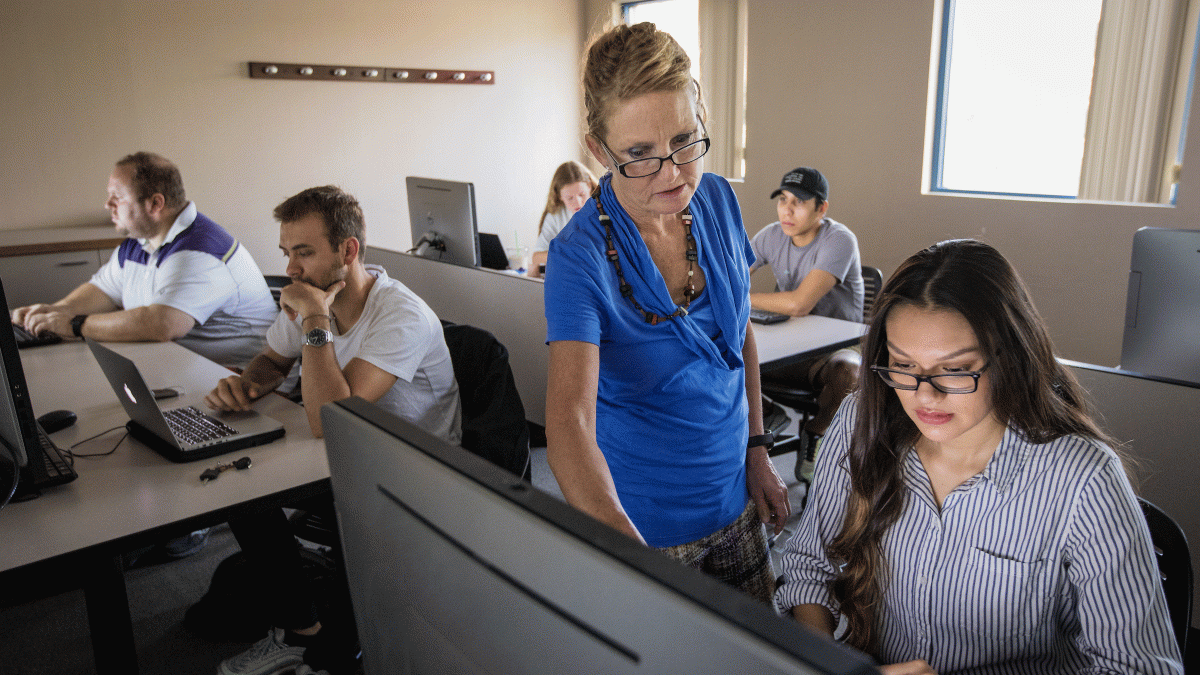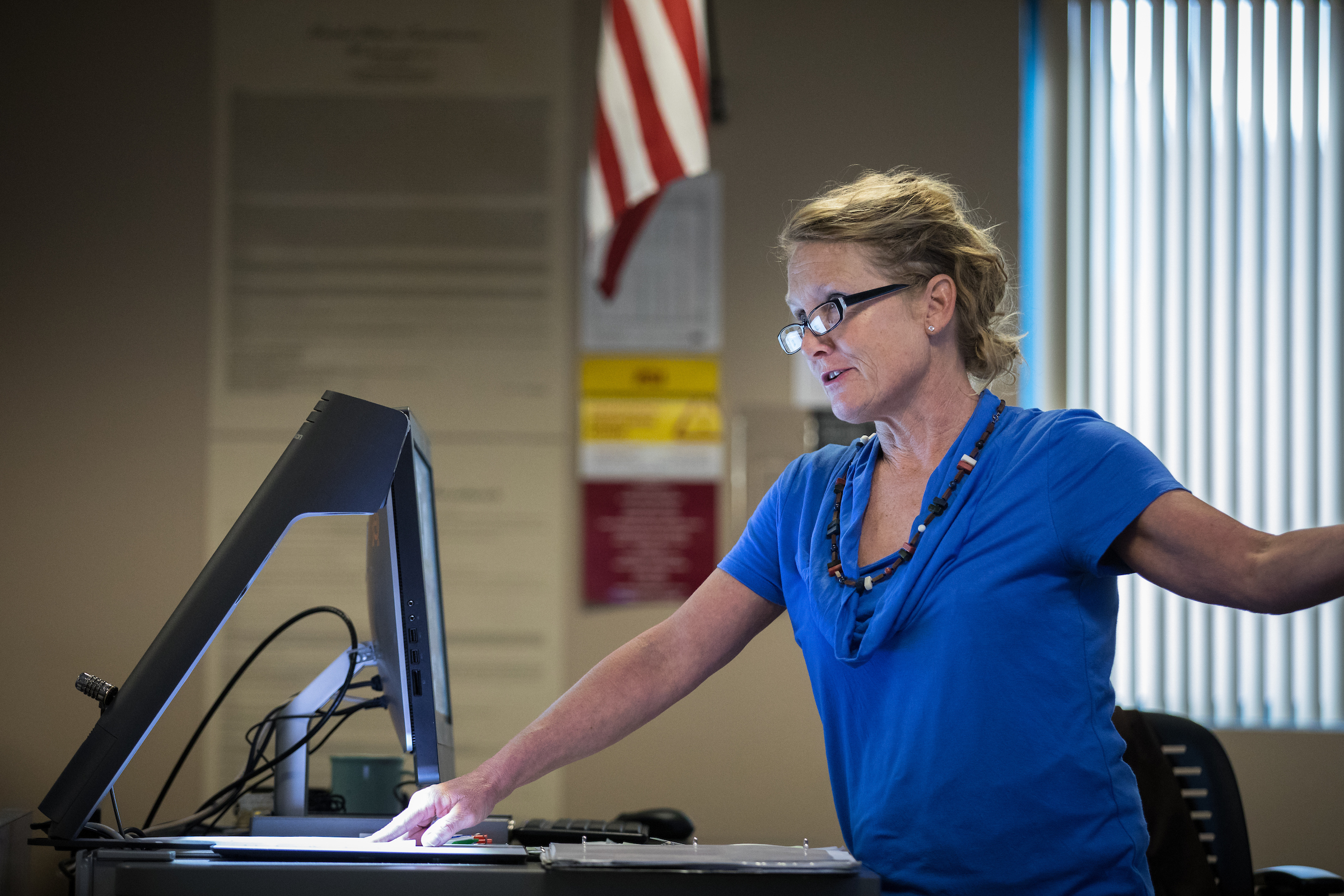It started with a textbook.
The required reading material ASU English instructor Elizabeth Ferszt had been using for her English 302: Business Writing course was “enormous; over 600 pages” and “so stunningly boring.”
There was even a section on how to write instructions to change a toner cartridge.
“I was like, are you kidding me?” Ferszt said. It didn’t seem like the kind of material she should be teaching students at the nation’s most innovative university, three years running.
“I take very literally our innovation culture here,” she said. “And it’s not just for the science teachers and the engineers, it’s for [English teachers], too.
“So I thought, OK. Goodbye teaching how to write about changing a toner cartridge. I want to teach my students how to write better, and write across all different platforms.”
Ferszt knew exactly the book to help her do that: “Start Something That Matters,” by Blake Mycoskie, the founder of TOMS Shoes.
She’d first encountered it while teaching at a community college in her home state of Michigan during a summer trip. The course used the first chapter of the book to show a practical application of an entrepreneur.
Ferszt devoured the book, and when she came to Chapter 8, she was delighted to find the star of it was none other than ASU alumnus Tyler Eltringham, whose nonprofit startup OneShot was directly inspired by the TOMS Shoes one-for-one business model.
Like TOMS does with pairs of shoes, OneShot donated one vaccination to people in need for every vaccination given in the U.S. The idea won the 2010–2011 Changemaker Challenge, a signature competition at ASU that rewards innovative, entrepreneurial endeavors.
What better book to use for her course, Ferszt thought, which is specifically geared toward W. P. Carey School of Business students.
If you’re thinking, What does a book about entrepreneurs have to do with teaching students how to write, you’re not alone. But Ferszt found a way to use the TOMS book — which is inherently more engaging than a traditional instructional textbook and has the bonus of getting business students to think differently about the field they’re going into — to get students to think differently about writing.
She didn’t want to teach students how to write memos, Ferszt said. She wanted to teach them how to use writing to do something.
For every chapter, Ferszt assigned reading questions, which, she said, at first “appear to be traditional reading questions in terms of content, but what they really do is generate a lot of fast, specific writing.”
“I think that’s one of the values of business writing, is you’ve got to go fast, and it has to be good. And how do you do that? Well, you don’t talk around it, you talk right at it. And you say exactly what this thing is about, and you pay attention to details.”
ASU English instructor Elizabeth Ferszt recently won a teaching award for her innovative use of the TOMS book in her classroom and the lasting affect it has had on her students. Photo by Charlie Leight/ASU Now
And it worked.
While responding to a set of reading questions Ferszt had assigned, her student Hilliary Farison found the inspiration and confidence she needed to write a proposal for her own business plan.
Farison, a business administration junior, had just participated in ASU’s Trash Hack, a competition aimed at finding new ways to repurpose and recycle plastic waste in the city of Phoenix. She and her team came up with the idea for polyethylene condoms made from recycled plastics.
The business uses the TOMS one-for-one model. For every condom purchase, the company will send a package to the World Health Organization to distribute to countries in need.
“I’ve always wanted to incorporate giving back to people,” Farison said.
Ferszt watched as student after student fell under the spell of the TOMS book.
“They love this book,” she said. “They flip out over it, and they buy it for their friends and their family. There’s just something about it, it’s really compelling and it’s really easy to read and so enthusiastic, like yes, you can do this.”
She coined the term “the TOMS effect” for how students were responding.
Zoila Harris, an economics senior who took Ferszt’s course in 2016, was inspired to create the nonprofit Zoila’s Closet to serve rural populations in her native Peru.
“Zoila was influenced by TOMS,” Ferszt said, “but it doesn’t have a one-for-one giving component because her entire project is a giving project.”
The central component of Zoila’s Closet is a community center, which Harris said will house a library, learning center, artisan space and clothing exchange. The goal is to “empower impoverished families to become independent, by providing food, clothing, shelter, literacy, and a venue to display and sell hand-crafted, Peruvian goods.”
When Harris brought the idea to Ferszt, the English instructor helped her submit it to the Changemaker Challenge, where it won $2,500.
“She’s been a major player,” Harris said of Ferszt. “She’s a great instructor because she encourages people, and she’s been with me throughout my journey, helping with the website and mentoring me.”
Ferszt also introduced Harris to the mkrspace at Hayden Library, where she said they’re following Mycoskie’s advice and taking advantage of the resources available to them to make dresses and T-shirts that can be sold on the Zoila’s Closet website.
“I take very literally our innovation culture here. And it’s not just for the science teachers and the engineers, it’s for [English teachers], too.”
— ASU English Instructor Elizabeth Ferszt
The writing on the website is all Harris, though, and Ferszt was impressed by how she was able to take such a big idea, with so many components, and explain it in such a concise, sensible way.
“To be a good writer, you have to be careful about details. Details such as the year that a company was founded, who are the CEOs, what is their core competency, where’s the domicile,” Ferszt said. “And then English details, like spelling and punctuation. So all those things matter.”
Ferszt recently won a teaching award for her innovative use of the TOMS book in her classroom and the lasting affect it has had on her students.
“I’ve been teaching for 30 years and this has never happened to me before,” she said. “It’s really truly because of this innovation culture [at ASU] that supports and encourages and says, why can’t you do this?”
And not just why can’t you, but why shouldn’t you.
“This book has sort of become the life of the class, and students love to see this because they think that when they work for a nonprofit or socially minded company, they’re going to have to give up material culture,” Ferszt said. “This shows them how they can make money, a lot of it, and still do a lot of good.”
Like the kind of good being done through ASU’s partnerships with companies like Starbucks and adidas to expand access to higher education — companies that incorporate a giving component in their business model from the beginning, rather than as an afterthought.
Ferszt is also showing her students other socially minded ways they can use what they’ve learned about writing, such as activism. Recently, she told them about the Saudi Arabian company Almarai Co., which purchased land in California and Arizona to farm alfalfa to send back to its home country to feed its dairy cows. It makes good business sense to the company, but it puts a strain on water resources in the two states.
“So I tell my students about those things and I’m like, 'Why don’t you all write to Senator McCain?' ” Ferszt said.
But she doesn’t stop there. Ferszt truly wants her students to realize their full potential and take advantage of all that one of the largest public research universities has to offer them.
“I always tell my students it’s not enough just to go to school,” she said. “You’ve got to get involved in all the stuff that happens here. That’s why you go to a big school, because there’s a lot of cool stuff happening, and 95 percent of it is free. And if you just go to school here and then go home, you’re not experiencing it all.”
One such opportunity Ferszt emphasizes to her students is the Founders Lab, members of which are privy to all things entrepreneur taking place at ASU.
“I try to get them to all sign up for Founders Lab. Probably only a handful do, but the ones that do find out about all the cool stuff and start thinking, ‘Wow, I’m not even graduated yet and I can still be part of these things.’ I love big schools for that reason. For all the resources.”
When ASU Now spoke to Ferszt, the following day was when her class was scheduled to read Chapter 8 of the TOMS book, the one that features Eltringham and OneShot.
It’s the day, she said, when “they have that ‘aha’ moment and they go, ‘Wait, this whole thing is actually connected to ASU?’ And I’m like, ‘Yes, this is how cool we are.’ It’s actual evidence of our innovation culture.”
Top photo: English Instructor Elizabeth Ferszt helps business administration junior Nichole Flores in the ENG 302 Business Writing class on Monday, helping her create a website with the Digication program. Photo by Charlie Leight/ASU Now
More Business and entrepreneurship

Boosting entrepreneurship to meet the market's needs
America loves an entrepreneur — the home run king of all businesspeople.And at Arizona State University, we love them, too.Here’s a look at how ASU prepares business students, alumni, development…

ASU Prep program turns students into statisticians through the power of sports
Ask a high school kid if they want to attend a statistics class, and they might give you a blank stare or just laugh.Ask them if they want to go to a professional baseball game and their response…
The business behind the brand
Ask Jennifer Boonlorn ('01 BS in marketing) about the secret to a successful career in the luxury fashion industry and she'll tell you that community building is top of the list."I want to share…



